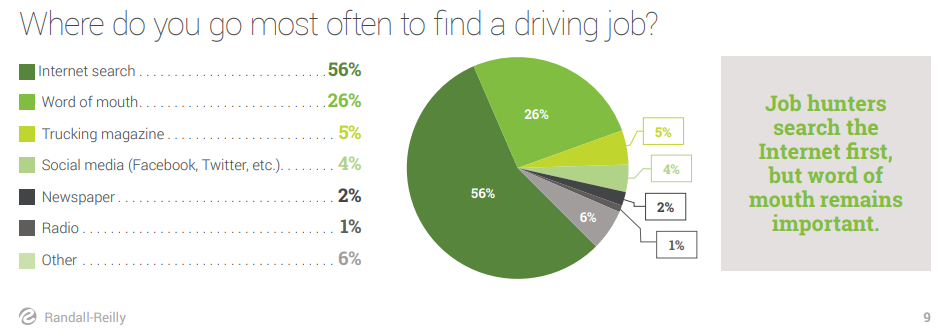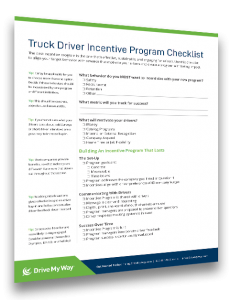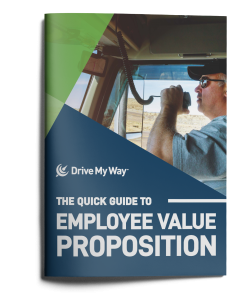
While orientation is a necessary part of the hiring process, it’s probably not something new drivers look forward to. While this is true, there are ways that trucking companies can make their orientations more enjoyable for drivers, that can lead to increased driver retention and morale. Here are 5 different ways to improve your truck driver orientation program.
1. Allow Drivers to Meet the Team
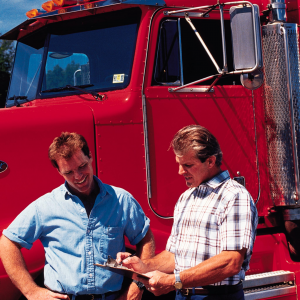 Instead of drivers coming in, meeting a trainer or two, and then being put on the road, schedule times for higher management and current company drivers to visit your next orientation class. They can share their thoughts and tips with new hires and do a Q&A session as well. This sends the message to your new drivers that they’re an important part of your company, which is extremely important for driver retention efforts.
Instead of drivers coming in, meeting a trainer or two, and then being put on the road, schedule times for higher management and current company drivers to visit your next orientation class. They can share their thoughts and tips with new hires and do a Q&A session as well. This sends the message to your new drivers that they’re an important part of your company, which is extremely important for driver retention efforts.
Your orientation could also be a great time to kick-off a mentoring program between more experienced drivers and new hires. Drivers appreciate having someone in the company that they can rely on once the driver is on the road.
2. Personalize the Program
Orientations don’t have to be rigid, point-by-point slideshows that share company policies and safety information. Take the time to personalize your orientation by talking to new drivers about areas of proficiencies at and what they could need help with. This helps you tailor your orientation so that you’re not boring some drivers while overwhelming others.
Another way to personalize your orientation is by using interactive learning. Administering quizzes and trivia games will keep orientation engaging and add incentive. It’s also a great way to see which drivers are understanding the material and who might need a little extra help.
3. Make it Unique

Avoid generic training videos to convey information. These can send the message that your company is the same as others, especially if a driver has seen the same video while working for a different carrier. Instead, opt for personalized training videos that feature your company logo and branding.
You can also do this by going the extra mile and giving small gifts or even a new hire kit of items drivers can use on the road. This has been shown to be a great way to increase employee retention as it further reiterates to your drivers that you’re excited they’re coming on board.
4. Offer Multiple Orientation Dates
The hiring landscape for truck drivers is extremely competitive right now. If you don’t act fast during the recruiting process, another carrier will. That’s why aside from making your orientation enjoyable, having it take place in a timely manner is also very important. Drivers don’t want to be told they’ve been hired, but that they need to wait two and a half weeks for orientation. That’s two and a half weeks without pay and the perfect way to have them sign with another carrier in the meantime.
To combat this, try to offer orientation classes a few times a month at least. Also, paying drivers to attend orientation is all but a must at this point. If your company hasn’t initiated this policy, make it a point of emphasis to start as quickly as possible.
5. Ask for Driver Feedback
Talk to current drivers who have already been through your orientation, as they’re the best resource you have. Ask them what could make it better, what they wish was covered, and what they think wasn’t necessary or could be done without. Thanks to their unique perspective, you’ll get insights you or your team would have never thought of. Do this often, as it will be your best way to constantly improve your orientation.
Your company’s driver orientation is a very important part of the hiring process. It’s the first real impression a driver will get of the company they’re driving for. It will also tell them whether they want to leave after a few short months or stay and build a long-term career with your company. Make sure it’s the latter by providing the best orientation experience possible.

Drivers are more likely to believe what a fellow driver says about a company than what the company itself says. That’s why truck driver referrals are so important when it comes to your company’s recruiting efforts.
It’s been shown that across all industries, hires that come from referrals lead to greater job satisfaction and longer employee retention. And specifically in the trucking industry, referrals are shown to be even more important.
According to Randall-Reilly’s Trucker News Connectivity Report, 26% of drivers rely on word-of-mouth when looking for a new job. While it doesn’t beat out the internet, that’s still a huge segment of drivers your company may be missing out on.

We spoke with Tim Yochum, Director of Recruiting of Drive My Way’s client, Foodliner. He spoke to us about the importance of referrals and how Foodliner secures them.
Why are referrals a key part of your driver recruiting efforts?
Referrals are usually more experienced drivers who enjoy having a connection with someone at the company. Many times, they’re passive candidates who aren’t actively searching for a new job. They become interested when a current driver speaks positively about their Foodliner experience. The length of employment for referrals is much longer than a non-referred driver. Our people know the job expectations and they look for referrals that will be a good match.
What are the top reasons your current drivers refer other drivers to your company?
Pay, Benefits, Home Time, Quality of Equipment, and Equipment Maintenance.
Do you have a referral bonus or a referral incentive that encourages referrals?
We offer an $8,000 Referral Bonus paid out in 3 installments during the first year.
Out of all the drivers you recruit on a yearly basis, what is the estimated percentage of drivers who find your company based on a referral?
Close to 20% of our new driver hires are referrals.
So, how does your company get these all-important referrals just like Foodliner has?
1. Create a Structured Referral Program
Creating a structured program is the first and most important step in bringing referrals in on a consistent basis. A referral program is where you offer current employees a monetary bonus or gift, in exchange for bringing in qualified new hires to the company.
Consider a scaled system, where the more hires a driver brings in, the more money they receive each time. Giving half the bonus at the time of hire and the rest when the new driver has completed x number of days is another tactic companies have used that helps with retention.
2. Advertise
A referral program doesn’t do much if drivers aren’t aware it exists. Making the program well-known throughout the company is almost as important as the program itself. When it comes to advertising, the more mediums you use, the better. One company-wide email probably won’t yield the kind of results you’re looking for.
Hanging flyers in the office, terminal, and break room, is a good start, but the best way to get the word out is to make sure that the program is consistently communicated from managers to drivers in multiple formats. This includes face-to-face conversations, email, text, phone calls, etc. Once the program has been ongoing for a while, try highlighting drivers who have already taken advantage of it. Showing that drivers in the company have had success with the program may urge others to do the same.
3. Offer Benefits that Drivers Want
 No matter how great your referral program is, drivers won’t participate if they don’t believe what they’re selling. Talk to your current drivers about what they enjoy most about your company, and what would make it better. More PTO, home time, and performance-based bonuses are common answers. Showing that the company is making an active effort to improve the quality of driver’s work life will improve morale and make drivers more likely to refer your company.
No matter how great your referral program is, drivers won’t participate if they don’t believe what they’re selling. Talk to your current drivers about what they enjoy most about your company, and what would make it better. More PTO, home time, and performance-based bonuses are common answers. Showing that the company is making an active effort to improve the quality of driver’s work life will improve morale and make drivers more likely to refer your company.
4. Provide Training and Education Resources
More and more drivers are looking to join companies where they’ll be able to grow and move into other roles, possibly non-driving positions and even management. This is why Training and advancement programs are another great way to increase referrals. Once a driver moves into a new role within your organization, their referral would go a long way in bringing drivers on board who are looking for the same opportunities. Even if some drivers aren’t interested, just giving them the option shows them that their employer is committed to their growth.
5. Be Honest with Job Seekers
After a driver has been referred and begins the interview process, be upfront about aspects of the job that aren’t a selling point, like when benefits start, possible night and weekend work. You may think that communicating these parts of the job might make the job less desirable, but many times it’s not. Drivers understand that not every position is going to meet all their wants. Drivers appreciate this honestly and will let that be known to other drivers when it’s time for them to refer someone else.
When it comes to driver recruiting, consistent and quality referrals can be the thing that sets your company apart. The good news is that there’s no secret or hidden trick to bringing them in. Creating a structured referral program, sticking to it and listening to your current drivers is all you need to bring in those all-important truck driver referrals.
 With thousands of carriers advertising jobs for truck drivers right now, how do you make sure yours resonates? If you’re recruiting for a smaller carrier, this can be even harder, since you may still be developing brand recognition. That’s not to say that creating a great job advertisement is an impossible task. It can seem daunting, but there are a few simple tips you can use to make sure your ads are getting noticed by the drivers you’re looking for.
With thousands of carriers advertising jobs for truck drivers right now, how do you make sure yours resonates? If you’re recruiting for a smaller carrier, this can be even harder, since you may still be developing brand recognition. That’s not to say that creating a great job advertisement is an impossible task. It can seem daunting, but there are a few simple tips you can use to make sure your ads are getting noticed by the drivers you’re looking for.
1. Don’t Oversell or Exaggerate
Truck drivers have a keen eye and low tolerance for job postings they find vague or suspicious. That’s why it’s extremely important to give drivers all the important and accurate information upfront when advertising jobs. When describing your compensation and benefits, avoid general terms like “competitive” or “fantastic” and instead, provide the details. While competitive means at or above market rate, the word has become so saturated over the last few years that it equates to “low” in the minds of many drivers. Drivers want to see hard numbers or odds are, they’ll quickly scroll away.
2. Be Thorough
You never want a driver coming away from your ad, asking themselves “What’s the home time? Pay? Is it full or part-time?” Here is a list of the things that should always be included in any truck driver job ad.
- Employee Value Proposition: This is where you’ll answer two very important questions. Why is my company different (and better) than the competition? What about my company is attractive to truck drivers? (Visit our blog on the topic to learn more about the best way to answer these questions.)
- Job Title: Include what CDL class is needed type of haul, and type of run
- Compensation: Include CPM or hourly, weekly, or yearly pay. Also include any sign-on bonuses or referral bonuses
- Benefits & Perks: What is covered under insurance, (health, vision, dental, etc.), PTO, 401K, etc.
- Home Time, Route, & Schedule: How often will the driver be home? What is the route and level of touch?
- Equipment: Truck specifics including technology and years of company trucks.
- Qualifications: Besides CDL class, are there other qualifications needed? Clean MVR? Minimum years of experience? Minimum age?
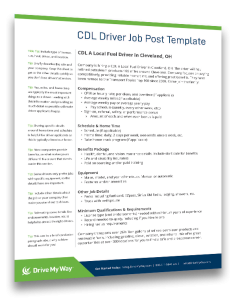 3. Make It Easy to Read
3. Make It Easy to Read
You could have the best job posting, with all the information a driver could ever want about the position and your company. But that won’t matter if it’s organized in a way that’s difficult to read. After you’ve gathered all the information you’ll need for a job ad, start organizing by what would be the most important information to a driver reading it. Start with pay, haul, type of run, and move down until you get to smaller details like the model year of trucks to be used and pet-rider policy.
Another best practice is to avoid using large blocks of text in your job ad. Instead, opt for bullets. This will make your job ad much more digestible for drivers, giving them an easy way to find information without scanning through chunks of text.
4. Partner with a Job Distributor
Where the ad is placed is just as important as how it’s written. With hundreds of job boards and social media channels out there, it can be a pain to know where your time and resources are best spent to reach the drivers you’re looking for.
Partnering with a recruiting platform like Drive My Way is the perfect way to get your jobs in front of qualified driver candidates. We create customized advertising campaigns that reach drivers in the right place and the right time. Just like we did with Button Transportation, a family-owned and operated trucking company in California, that hired 10 new drivers within the span of just two months.
Your job ad is likely the first impression a driver will have with your company, so making sure it’s a good one is key. The good news is that advertising jobs for your trucking position isn’t rocket science. Just put yourself in the shoes of the driver. If you were looking for a job, what information would you like to see and where would you like to see it?

The company pitch is extremely important when recruiting drivers. You only have a few minutes to talk to a driver and tell them why working for your carrier is the right choice for their career. So, how do you make sure you’re making the most of your time?
What is a Trucking Company Pitch?
A trucking company pitch is where you introduce your company to a driver and explain why they would want to drive for you. Trucking pitches are used during the first point of contact with a driver.
The most important thing to remember is that these pitches aren’t one size fits all. They should change based on the role you’re hiring for and any information you have on the driver and what they find important. Here’s an example of an effective Trucking Pitch.
“Hello. Thanks for taking the time to speak with me. I work with ABC Trucking and we’re looking for Regional Dry Van Drivers in the Midwest. We’re offering qualified drivers $1,400 guaranteed weekly, full health, vision, and dental benefits, weekly home time, and a $2,000 sign-on bonus. Does that line up with what you’re looking for right now?”
How to Perfect Your Pitch
We spoke to Michelle Habart, Business Development Coordinator for Drive My Way’s client, CLE Transportation, about how she structures her trucking pitch to drivers.
Michelle Habart CLE Transportation
“First, I introduce myself and the company. I start with who we are, where we’re located and then ask questions to find out what their needs are. For example, if it’s home time, I am only going to offer them what I have that fits the needs they are trying to fill. I want to make it clear that we have options. If it’s equipment, then we will go over that in detail. If it’s pay then we go over the packages and benefits we offer, like bonuses, 401K, and profit sharing. I make sure they understand that health insurance is paid by the company because that will save them money.
Next, I jump into the basic questions like experience, history and driving record. I will then send them the link to fill out the application and make it known that I am available to answer any questions that they have.” shared Michelle.
Keep it Short, Specific and Avoid the Jargon
As you probably know, any driver you’re speaking with is probably speaking with at least one other recruiter as well. Keeping your trucking pitch quick and to the point is the best way to keep their attention and further the conversation. Avoid vague statements like “we offer competitive pay and new equipment.” Drivers looking for work read that dozens of times a day. This won’t do anything to help differentiate you in their mind.
In general, drivers don’t like to beat around the bush. Avoid using buzzwords and jargon where it’s not necessary. The best practice here is to write down your pitch then read it out loud to yourself. Does it sound forced or unnatural? Chances are if it does to you, it will to the driver as well.
Make it a Conversation
The next part to perfecting your pitch is to make it a conversation. Many recruiters make a habit of rattling off ten different things and then asking, “how does that sound?” The driver probably forgot the first three things you said by this point and will reply with a half-hearted, “Sounds good.” That’s not a conversation, it’s an information dump.
Instead, ask questions throughout the pitch and try to make it a two-way street. After you give the important info, ask questions like, “Does that line up with what you’re looking for?” The most important part here is to make sure the job is a mutual fit on both sides. There’s no point in trying to force a square peg into a round hole.
Don’t Oversell/Misinform
Overselling is a common issue in driver recruiting. It’s understandable that recruiters want to do everything they can to bring drivers in the door, but the last thing you want to do is promise something that you can’t deliver on. This leads to unhappy drivers that will probably be looking to exit as quickly as they came.
“Here at CLE Transportation, we don’t sugar coat anything. Getting a driver isn’t about filling a seat. It’s about doing the best we can to make sure that the driver and our company will be a good fit for each other. We are not trying to waste our time or theirs. We don’t treat them as just another driver looking for a job, we treat them as professionals, because that’s what they are. It’s not just an interview process, it’s about hearing them.
They need to know that we’re here for them during the entire process, from the initial “hello” all the way to them leaving to deliver that first load. Even then they can call me for questions they have. After I set up an orientation date, I will send them a picture of the truck that they will be in.” shared Michelle.
Be Prepared for Common Objections
Drivers will almost certainly have things that they consider non-negotiable. This can be anything from home time, specific compensation, type of equipment, etc. Instead of thinking it’s a dead end if a driver pushes back on one of these, try and talk through it.
The best way to do this is by asking questions like, “what is it about x that you dislike?”, or “What would make you consider x?” More often than not, this can lead to a compromise where both sides are happy.
The trucking company pitch is something that takes time to perfect. The most important thing isn’t to sell the position at all costs. It’s to present the most important information related to the job while making sure it’s a good fit for both sides.

With the huge changes in the U.S. economy over the past two years, almost every major and local retailer is offering some sort of delivery service. This has made the market for non CDL drivers grow at a considerable rate.
 We spoke to Christian Rivera, a National Recruiter for Drive My Way’s client, Need It Now Delivers. He shared his perspective about the recruiting process and the qualities he looks for in non CDL drivers.
We spoke to Christian Rivera, a National Recruiter for Drive My Way’s client, Need It Now Delivers. He shared his perspective about the recruiting process and the qualities he looks for in non CDL drivers.
“Our hiring approach for non CDL Drivers does not change too much. We’re in communication throughout the process and disclose all parts of the job, just like we would for CDL Drivers. In the ideal non CDL driver, I would say we look for four things; a clean driving record, stable previous employment (preferably staying one year or more), good safety habits, and a customer first attitude,” shared Christian.
1. Nature of the Job
Like it is when recruiting CDL drivers, the number one thing that will help you is to be honest and knowledgeable about the position. Some drivers may be fine with just knowing the pay, schedule, and benefits. Others may want to know details on route, breaks, and day-to-day operations. Being ready to answer these questions is the best way to make sure it’s a fit both the driver and your company.
Make sure to disclose any customer service-related aspects of the job as well. Drivers want to know if they’re expected to just drop off deliveries or drop and have someone sign. In addition, they will need to know if the job requires full White Glove service, where they’ll be entering homes and businesses to install equipment or appliances.
It’s also important to understand that many non CDL drivers may not be in the trucking industry for advancement opportunities or to eventually earn their CDL. While some are, other non CDL drivers are simply looking for a job instead of a long-term career in trucking.
2. Home Time and Flexibility
Just like with CDL A or B local drivers, non CDL drivers will value home time more than almost anything else. While this shouldn’t be a problem with local routes, make sure to communicate what their home time will look like. Many times, drivers are expected to stay late to help with extra deliveries. While this is part of the business, drivers should be told upfront to avoid any surprises.
 3. Schedule, Hours and Routes
3. Schedule, Hours and Routes
One thing that non CDL drivers are most likely looking for is part-time possibilities. Opposed to CDL work, non CDL drivers may only have night, weekend or certain weekday availabilities.
That’s why it’s important to work with drivers to make sure their availability is respected. Scheduling employees outside of their agreed upon availability can not only lead to bad company culture, but it could also leave you and your customers high and dry if the employee decides not to show up on a particularly busy day.
4. Pay
Just like the costs for a CDL B license are lower than a CDL A, a non CDL driver incurs low costs before hitting the road. Because of this, pay across the board for non CDL drivers is understandably lower. At the same time, there is a ton of competition on the employer end for these drivers. Keeping an above average pay scale while providing performance-based bonuses is the best way to get the attention of experienced and talented non CDL drivers.
5. Company Culture
Since non CDL Drivers will likely be interacting with other co-workers and management on a daily basis, building a culture of communication and camaraderie is essential to keep morale high and drivers motivated. This can be done through daily team meetings before drivers head out on their routes, where important information is conveyed, and any questions or grievances drivers have can be talked about.
Just like with CDL drivers, non CDL drivers have their own unique characteristics and reasons they chose their line of work. Understanding this and what they find important is the key to bringing qualified, experienced drivers on board.

With the recent e-commerce explosion, companies have an increased need for “last mile” sprinter van drivers. While most companies prefer to hire their own drivers, a growing number are starting to hire independent Owner Operators to help with the influx of orders. Additionally, more and more drivers who owned their own truck are downsizing to sprinter vans to increase home time, cut costs, and avoid CDL regulations.
When it comes to recruiting these drivers, it can be difficult to know what you need to do to stand out from other companies. Here are 4 of the most helpful tips successful recruiters follow when recruiting sprinter van Owner Operators.
1. Know Your Drivers
The first tip is to know the type of drivers you are recruiting. If a driver owns their own sprinter van, he or she will likely be more experienced and entrepreneurial-minded than an average company driver. Like all Owner Operators, sprinter van owners value job flexibility. That’s most likely why they became an Owner Operator in the first place.
Since there’s a huge demand for their services, they can be much more selective in the type of work they pick up. They’ll want to see the long-term benefit before they consider partnering with your business.
2. Disclose Everything Related to the Job
One of the biggest issues that drivers point out with recruiters is an apparent lack of honesty. Often, this isn’t because the recruiter is doing anything dishonest or deceptive, it’s because he or she isn’t informed on everything the driver finds important. When it comes to Owner Operators, this becomes especially apparent.
As stated earlier, these drivers view working with your company as a partnership, not simply a job. It may not be enough to simply provide Owner Operators with the pay, equipment requirements, and the hours. They may want to know the overall business goals, culture, and operations of your company before they partner with you. It’s important for recruiters to be well-versed in all these things before reaching out to Owner Operators.
 3. Go Where Owner Operators Are
3. Go Where Owner Operators Are
Just like company drivers, Owner Operators use a variety of job boards to find employment. But, if you’re looking to hire a large number of sprinter van Owner Operators, your best bet may be to advertise with print magazines. According to the Overdrive 2016 Connectivity Study, Owner Operators read industry magazines at a much higher rate than other drivers.
Utilizing your network of past and present drivers can be another huge resource in tracking down quality sprinter van Owner Operators who may not be on job boards. According to that same study, 43.8% of drivers find new jobs by word of mouth referrals.
4. Respond Quickly and Professionally
Drivers are in high demand right now. The ones who are actively looking for work can afford to be picky with who they partner with. If you’re not staying in contact throughout the hiring process, they’ll quickly move on to the next opportunity. According to data captured through Drive My Way drivers, the top reason candidates declined job offers is because they just accepted an offer from someone else.
This may mean being available outside of normal business hours. If you’re recruiting for a national company, be ready to take calls a few hours before or after the traditional 8AM-5PM workday to account for different time zones and driver shifts.
Another tip is to make sure you’re getting back to all the drivers who have applied, even if the news isn’t good. It can be a difficult conversation, but avoiding it can lead to a negative impact on your company’s reputation. A LinkedIn survey found that 94% of respondents said they want to receive feedback on their interviews, good or bad. Not every Owner Operator will be a good match for your company, but having a quick and transparent hiring process will make them much more likely to tell other Owner Operators good things about your company.
While there is a lot of competition right now for sprinter van Owner Operators, following these key tips will make the recruiting process for you and the driver easier and more productive.
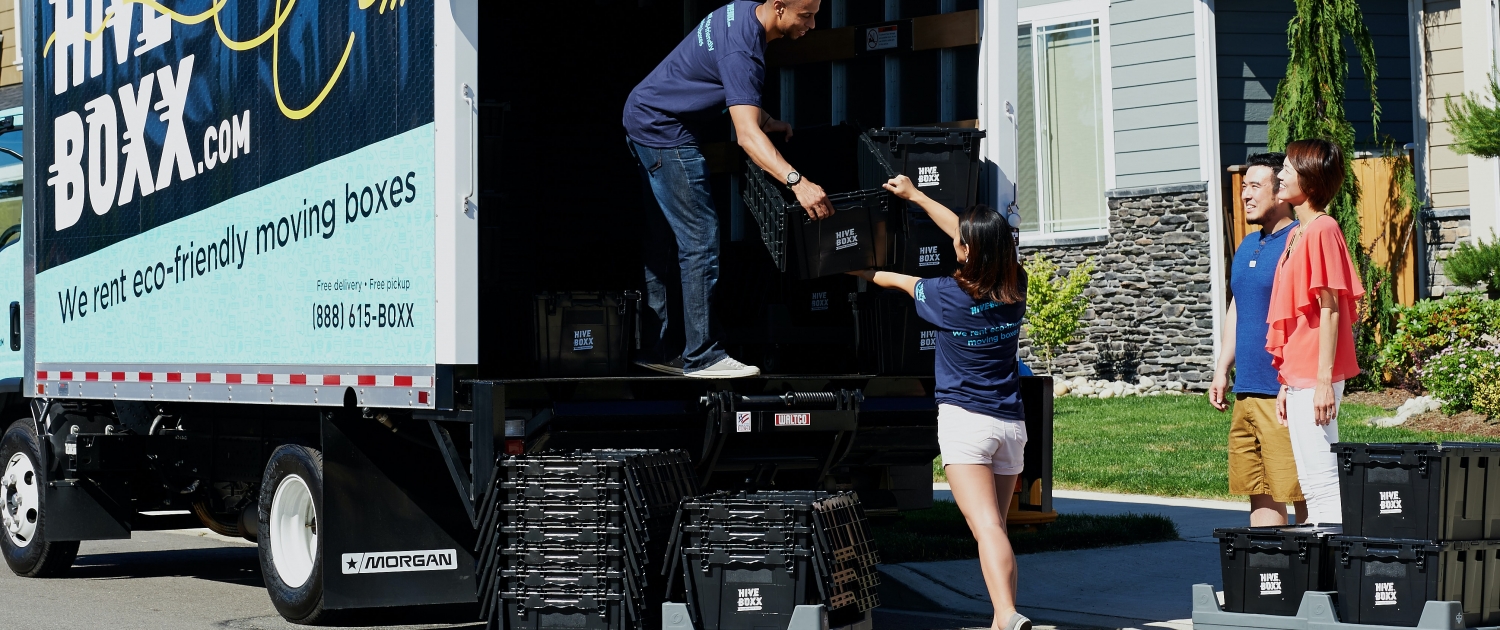
Hiring high-quality straight truck drivers is no easy feat right now. The demand for drivers is high, and the supply of drivers doesn’t match the current demand. That means that it’s a driver’s market, and companies must offer quality jobs that stand out to drivers to attract top talent. If you’re hiring straight truck drivers, these four tips will help you get the most out of every online or personal recruiting message.
1. Create Driver Personas
The first step to effectively hiring straight truck drivers is to know exactly who you are looking for. Driver personas are an opportunity to paint a picture of your ideal employees. What skills and endorsements do they have? Are there specific personality traits that are important to your jobs? Go beyond surface characteristics. Once you have a general idea of your ideal employees, consider what motivates these types of drivers.
As you develop your driver personas, study what makes straight truck drivers unique. Typically, straight truck drivers are looking for local work and regular home time. Many may have a family that they want to spend more time with. These drivers may not have a CDL A license. Their license type may give you insight into what kind of driving career that driver is looking for. A well-developed driver persona should clarify and direct recruiting efforts for hiring straight truck drivers.
2. Speak to Driver Priorities
Straight truck drivers are highly sought after right now. It’s a driver’s market, so companies need to make jobs appealing in order to stand out from the competition. Driver personas give insight into your ideal candidates, and this information is valuable. Use the insights on driver motivation and priorities to inform recruiting and marketing decisions. Driver priorities should be front and center in online marketing and advertising. In addition, these details can be part of recruiting conversations. Not all driver candidates will fit your profile, so take the time in recruiting conversations to ask a few questions about driver goals and priorities. Then, highlight how your available jobs are a good fit for that candidate.
It’s a driver’s market, so companies need to make jobs appealing in order to stand out from the competition.
When speaking with drivers, get them the information they care about quickly and succinctly. The driver personas can help guide the tone and content of your conversation, but the basics are still essential. Drivers want to know about compensation, home time, schedule, route, equipment, and customer interaction. Be specific when you share this information and give precise details on the job requirements. In job descriptions and recruiting conversations, include all required qualifications, skills, years of experience, and other prerequisites. This will help drivers self-select whether they fit your requirements and will save time for everyone involved.
3. Embrace Digital Recruiting

Hiring straight truck drivers is a competitive challenge, and digital recruiting is a must. Many companies start with a basic website and social media channels because they are easy to set up and are typically free to start. That said, there are other online recruiting tools such as search engine optimized content marketing and job boards if you want to branch out. For any channels you choose, establish trackable metrics so you can determine which channels perform well.
Regardless of the channels that you utilize, a clear brand must help communicate your story. Be consistent in imagery and content tone across all platforms. Give drivers something they can recognize as distinct to your company. Photo and video content are powerful recruiting tools because they help drivers see themselves in the job. Many drivers are not job searching on a computer, so make sure all content is optimized for mobile.
4. Support Driver Referral Programs
Driver referrals and word of mouth recruiting still reign as powerful recruiting methods. At the end of the day, nothing replaces a trusted source, and truck drivers trust other drivers. Referrals can be even more powerful in a local setting such as when hiring straight truck drivers because these truckers travel in the same circles. They are talking regularly and will be job searching in the same geographies. Word travels fast when companies have a distinctly positive or negative reputation, so make sure your drivers have good things to talk about!
Nothing replaces a trusted source, and truck drivers trust other drivers. Driver referrals are a powerful recruiting resource.
As a company, driver referrals, especially from top team members, help get other quality drivers in the door. A referral from a trusted source is a little extra confidence that interviewing the candidate will be worth your time.

Driver misclassification is not a new problem as part of trucking regulations. If a driver fills the role of a company driver, but the employer pays them with a 1099 as an independent contractor, there’s a problem. That driver is likely misclassified, an error that employers can face serious consequences for. Recent Legislation, such as the PRO Act, was developed to help combat driver misclassification. Unfortunately, it also effectively eliminates the owner operator business model. Here’s what you need to know about the state of the PRO Act in Congress and driver misclassification.
What Is the PRO Act?
If you follow political or legal developments in trucking regulations, you’ve likely been following the PRO Act. This bill, formally known as the Protecting the Right to Organize Act, intends to protect workers from unethical employment practices, but it has alarming consequences for the owner operator business model. The PRO Act is similar to California’s Assembly Bill 5 (AB5), and it sets very specific criteria for gig workers. Unfortunately, in trucking, this also applies to owner operators.
Under the PRO Act, for a company to employ an independent contractor (like an owner operator), the partnership must pass an ABC test. According to the PRO ACT, an independent contractor must meet the following criteria:
“(A) the individual is free from control and direction in connection with the performance of the service, both under the contract for the performance of service and in fact;
(B) the service is performed outside the usual course of the business of the employer; and
(C) the individual is customarily engaged in an independently established trade, occupation, profession, or business of the same nature as that involved in the service performed.”
As part of trucking regulations, the B prong is usually the hardest to satisfy. Section B requires that independent contractors must be doing work outside of the scope of normal business. Unfortunately, in an owner operator model, those drivers are at the heart of a successful operation. Trucking experts are raising concerns that the PRO Act may effectively eliminate the current owner operator model. To date, the PRO Act has passed in the House of Representatives but has not made it to the Senate floor for discussion yet.
What Is the PRO Act Trying to Solve?
 Many trucking regulations experts are strongly opposed to the PRO Act, but there is an underlying problem that this Act brings to the surface. The PRO Act tries to prevent companies from “employing” workers without offering benefits AKA misclassifying drivers. In many cases, this pushes the cost burden to the individual driver. However, owner operators are business owners, and many enjoy the freedom, income potential, and flexibility that comes with their role.
Many trucking regulations experts are strongly opposed to the PRO Act, but there is an underlying problem that this Act brings to the surface. The PRO Act tries to prevent companies from “employing” workers without offering benefits AKA misclassifying drivers. In many cases, this pushes the cost burden to the individual driver. However, owner operators are business owners, and many enjoy the freedom, income potential, and flexibility that comes with their role.
While the owner operator model works well for many truck drivers and carriers, driver misclassification is still prevalent in the industry. Misclassified drivers include those who earn pay as independent contractors and do not have guaranteed work but work like company drivers. There is a difference between owner operators who run under their own authority and misclassified truck drivers, however, the PRO Act includes both.
What Is Driver Misclassification?
Driver misclassification occurs when fleets try to pay company drivers as independent contractors. By classifying company drivers as 1099 employees, carriers illegally avoid paying full benefits to their drivers. Owner operators are a different business model. They are independent contractors. True owner operators run their own business. They partner with carriers based on a mutually agreeable contract and may run for multiple carriers simultaneously.
If you are uncertain about the appropriate driver classification for your fleet, there are ways to check.
Does the driver:
- Do their job under their own direction? For example, can drivers refuse loads if it doesn’t meet their criteria?
- Pay lease, maintenance, and insurance costs? Have proof of vehicle registration in their name?
- Have the ability to work for another company?
If you said “no” to any of these questions, you are employing a company driver. In that case, the driver should earn pay as a W2 employee and be eligible for benefits.

Brian Dershaw, Partner at Taft Law
We spoke with Brian Dershaw, Partner at Taft Law, and he shared Taft’s response to companies with concerns about misclassification:
“In many instances, contractor classification may be an essential component of the company; the consequences of misclassification could be detrimental. With that in mind, we continuously navigate the federal and state tests in this area. This includes guiding clients in ways to maintain their independent contractor classification and, if appropriate, advising on the transition to an employer-employee model.”
Paying a company driver as a 1099 employee is illegal and can lead to serious consequences, but there are legal resources, such as Taft Law or other firms, that can help.
What Are the Penalties for Driver Misclassification?
The legal ramifications for driver misclassification can vary based on the situation. In some cases, the company is required to pay back the money owed to the driver based on the loss of income and benefits. In severe cases, companies may face additional fines or time if the misclassification is found to be deliberate.
When asked about driver misclassification penalties, Taft Law’s Brian Dershaw, shared:
“If an employee is misclassified as an independent contractor, that can raise serious issues across the employment spectrum. These include wage and hour issues such as overtime under the FLSA and state laws, unemployment compensation, workers’ compensation, health insurance benefits, and employee-specific anti-discrimination and leave laws (e.g., ADA, Title VII, ADEA, and FMLA). Misclassification can result in steep financial penalties and other damages.”
Misclassifying drivers as independent contractors when their role is as a company driver is a serious offense. The PRO Act may not be an effective solution to driver misclassification in the trucking industry because of its reaching consequences for owner operators. However, driver misclassification is a serious problem, and carriers should take immediate action to rectify any misclassification in their fleet to avoid legal consequences.
STAY UPDATED ON INDUSTRY TRENDS AND BEST PRACTICES
Join our community of thousands of employers who receive our updates.

The higher the driver qualifications, the better the driver applicants. Right? Not always. In some cases, high minimum qualifications bring top driver leads, but it may also cause you to miss top drivers who are strong candidates but don’t meet your minimum criteria. Especially when you are hiring for several positions in challenging geographies, you may be better off with a high-volume hiring strategy. If you’re having trouble getting good drivers behind the wheel, rethink your minimum qualifications and open your hiring pool.
Find True Minimums
When you set minimum qualifications, are you starting with the true minimums? Before you modify the job description to fit your internal, company-specific qualification minimums, start with federal and state requirements. Many companies aim above the 21-year-old age minimum for interstate driving or simply displaying a valid CDL. However, it’s important to be strategic about where to raise the bar and where to keep minimums at or near their base level. When you do finalize hires, best practices include keeping a driver qualification file for each driver.
Use the Job as the Foundation
Before you set minimum qualifications in a job posting, closely analyze the details of the job in two rounds. In Round 1, make a list of the skills and qualifications that you are looking for in a driver. Which ones are “nice to haves” and which ones are essential for a driver to be able to successfully complete the job? Are any of the skills or qualifications that you listed in Round 1 on the list primarily because they are intended to drive up application quality? For requirements that are just “weed-out” criteria, consider lowering your bar slightly to increase the hiring pool for jobs that are difficult to fill.
Which ones are “nice to haves” and which ones are essential. Distill your qualifications list to the true minimums.
In the second round of developing appropriate minimum qualifications, focus on the “need to haves.” Distill your qualifications list to the true minimum qualifications. Use federal and state requirements as well as the minimums that you determine for your company and the specific job in question. Do not inflate the required qualifications from the essentials. Keep all of the necessary qualifications on the job description skills list. From there, determine your next round of priority qualifications. Decide where to increase your minimum qualifications and where to leave them at their baseline.
Minimum Qualifications Are Not Static
Once you have reevaluated the qualifications for each job posting, consider those requirements the starting point. Optimize minimum by making them responsive to driver supply and job demand. When applicant volume is low, decrease the minimum qualifications to increase the hiring pool. This is often an effective recruitment strategy when hiring in challenging geographies with limited drivers. Even within a single company, some jobs may mandate different qualifications.
Qualification requirements are not static. When applicant volume is low, decrease the minimum qualifications to increase the hiring pool. When applicant volume is high and job demand is low, consider increasing minimum qualifications.
On the other hand, when applicant volume is high and job demand is low, consider increasing minimum qualifications. Rapid changes to job postings may cause interested drivers to get frustrated by the perceived changing standards. Increase the required qualifications gradually to find the balance point between a sufficient candidate pool and maximizing driver quality. Then, boost your efforts with other recruiting best practices to connect with the drivers who will be valued members of your fleet.

Most carriers in the United States now offer some form of a truck driver sign-on bonus. In 2010, that number was zero. There has been a dramatic increase in the popularity of sign-on bonuses, and at this point, sign-on bonuses are almost an expectation from truck drivers. However, if most companies offer sign-on bonuses, competition to recruit quality drivers becomes that much tougher. Here’s what you need to know to stand out to the right drivers and fill your fleet.
Why Are You Offering A Sign-On Bonus?
The bottom line is that a truck driver sign-on bonus can make your job more attractive. Sign-on bonuses aren’t the total compensation package, but if a driver is between your job and another similarly competitive position, a sign-on bonus might be enough to tip them to your side. However, a sign-on bonus that doesn’t also improve driver retention is not taking full advantage of the program’s strength!
 We spoke with Riverside Transport, a top Dry Van carrier in the Midwest, and they shared this about the impact of a sign-on bonus on their driver recruitment and retention.
We spoke with Riverside Transport, a top Dry Van carrier in the Midwest, and they shared this about the impact of a sign-on bonus on their driver recruitment and retention.
“Drivers love getting the extra pay for sign-on-bonuses. It definitely helps with their cash flow, thus drivers tend to stick it out with us to ensure they get their bonus payouts. It becomes a win-win when the drivers stay, earn more, and then statistically get past the 90-day mark. That driver could theoretically be a part of the RTI family for the long stretch. That is the ultimate hope with our efforts.”
At the end of the day, the goal is not just to get drivers in the door, but to keep them with your fleet, reduce turnover, and save recruiting costs. Use variables such as the dollar amount and distribution period to fine-tune your sign-on bonus efficacy.
How Much Should You Offer?
The question of dollar amount is an important one for sign-on bonuses. If you don’t offer enough money, drivers might find the offer stingy or simply not attractive enough to change jobs. On the other hand, if you put a number that’s too high, drivers might be skeptical. Some drivers may see an uncommonly high truck driver sign-on bonus as a sign that your company is compensating for negative job elements.
When asked about determining the right bonus amount for your drivers, Riverside Transport shared:
“Be flexible with your sign-on bonuses based on market needs, make them attainable and realistic and not so over the top to scare away drivers. Many drivers can be leery of sign-on bonuses.”
Riverside continued, “Realistic sign-on bonuses with payouts that are are reachable [help] get the driver past the 90-day mark in terms of payout. This benefits both recruitment and retention, and is nice for our drivers.”
Unfortunately, there’s no uniform amount for every situation! One driver’s “too low” might be close to another driver’s “too high.” Ultimately, there is no set dollar number.
Since there is no standard dollar amount for sign-on bonuses, decide an amount based on your recruitment budget and the drivers you need to attract. Some companies offer all drivers a flat rate truck driver sign-on bonus. This simplifies job descriptions and ensures that there are no concerns about fairness between drivers. Other companies favor a variable sign-on bonus rate. Drivers may be paid more with more experience, endorsements, or other specific qualifications. Variable rates can be particularly attractive to experienced drivers who would earn the larger sign-on bonus.
When Should You Give the Bonus?
 The best sign-on bonus program is the one that’s engaging for drivers and sustainable. It’s as simple as that. With that in mind, keep your incentive program as straightforward as possible. First, identify what behavior you are trying to incentivize.
The best sign-on bonus program is the one that’s engaging for drivers and sustainable. It’s as simple as that. With that in mind, keep your incentive program as straightforward as possible. First, identify what behavior you are trying to incentivize.
For a sign-on bonus, set your sights on recruitment AND retention. Are you having a hard time getting in the door, but retention is strong? Is recruitment strong, but turnover is high? Are both areas a challenge?
To encourage retention, consider a phased approach with multiple distribution phases. Some employers offer a truck driver sign-on bonus that is paid out over the course of 6 months or a year. For example, Drive My Way client Armellini Express Lines pays their sign-on bonus to drivers over a one-year period to boost retention.
Extending the pay-out period encourages drivers to stay with the company until they receive their full bonus. The first few months after a new hire have one of the highest turnover rates. An extended bonus period can hold drivers through the adjustment curve and boost retention in the long term.
What Should I Communicate To Drivers?
A truck driver sign-on bonus program is just one part of a total compensation package. Advertise the sign-on bonus with the job description, and make sure the rest of the compensation package is a strong offer. Many drivers have been burned before, so be prepared to answer skeptical questions about the offer.
Be clear about how much drivers will receive and when they will get the money. Make sure to be transparent about the bonus from the beginning. There shouldn’t be any surprises for the drivers later on otherwise you risk building resentment. If there are any additional stipulations on the money, make sure drivers understand. If they feel jilted, they’ll talk about it, and it will kill your reputation. The best way to create a positive program is with thoughtful program structure and transparency for drivers.



